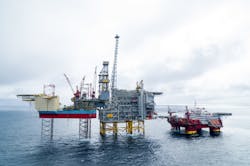Offshore staff
STAVANGER, Norway – Equinor and its partner Petoro have started production from the Martin Linge oil and gas field in the Norwegian North Sea.
Discovered in 1978, Martin Linge is 42 km (26 mi) west of the Oseberg complex, in 115 m (377 ft) of water.
The development comprises a jacket-based integrated wellhead, production and accommodation platform and a permanently anchored oil storage vessel. The oil is processed on the storage vessel and transported from the field in shuttle tankers to the market. The gas flows through a new pipeline connecting the field to the existing pipeline going to St. Fergus, Scotland.
Expected recoverable resources are about 260 MMboe. Equinor expects the field to reach plateau production of around 115,000 boe/d in 2022.
Equinor is the operator with a 70% working interest. Petoro holds the remaining 30%.
The Martin Linge platform receives power via the world’s longest alternating-current sea cable measuring 163 km (101 mi) from the onshore substation at Kollsnes in western Norway.
The platform was connected to shore power in December 2018 and was soon followed by the storage vessel on the Martin Linge field. This is the world’s first storage vessel receiving power from shore, the company claimed.
Martin Linge is also the first platform on the Norwegian continental shelf to be put onstream from shore. The production wells and processing plant are operated from the control room in Stavanger, and the offshore operators use tablets in the field to interact with their colleagues in the onshore control room and operations center. Onshore control room will reduce costs in the operating phase, Equinor said.
The Martin Linge project has faced many challenges. Production was originally scheduled to start in 2016. The costs of the project have risen to NOK 63 billion ($7.3 billion), compared to the original NOK 31.5 billion ($3.6 billion) in the 2012 plan for development and operation.
Equinor acquired Total’s interests in the field in March 2018. At the same time, it took over the operatorship and responsibility for completing the field development project.
Approximately 2,500 people offshore and onshore have worked on preparing the platform for production. In general, offshore completion is challenging for a project extending over several winter seasons. The COVID-19 pandemic, with restrictions on personnel and other infection control measures, have also led to further delays, the company said.
07/01/2021



